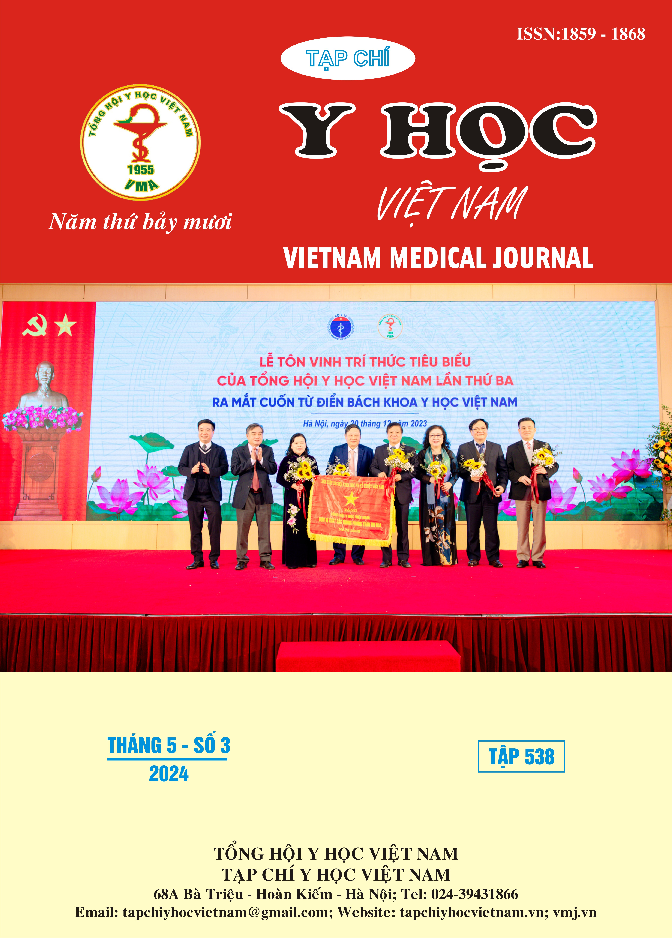ASSESSMENT OF SCAI SHOCK STAGE IN PATIENTS WITH ACUTE HEART FAILURE ADMITTED TO INTENSIVE CARE AND TOXICOLOGY UNIT AT AN GIANG CARDIOLOGY HOSPITAL
Main Article Content
Abstract
Background: A new 5-stage classification of acute heart failure (AHF) was recently introduced by the Society for Cardiovascular Imaging and Interventions (SCAI) with the purpose of stratifying the mortality risk of cardiogenic shock. Objective: To implement shock severity assessment for patients with AHF within the first 24 hours of hospitalization and monitor short-term treatment outcomes over 30 days based on the SCAI SHOCK stages. Population: All patients over 18 years old who were admitted to Intensive Care and Toxicology Unit and met the diagnostic criteria for AHF as established by ESC 2021 or were diagnosed with acute myocardial infarction and had consented to participate in the study. Method: This is a descriptive cross-sectional study. A convenience sampling technique and a structured questionnaire was used to collect the data. Results: Among 150 patients meeting the study criteria, the proportion of patients classified into SCAI SHOCK stage from A to E was 8.7%, 43.3%, 25.3%, 10.7%, and 12%, respectively. After a 30-day follow-up, the overall survival rate was 58%, with survival rates for each stage as follows: SCAI A 92.3%, SCAI B 89.2%, SCAI C 44.7%, SCAI D 0%, and SCAI E 0%. Conclusion: The SCAI B stage had the highest prevalence in Intensive Care and Toxicology Unit at An Giang Cardiology Hospital. During the 30-day follow-up period, the overall survival rate of the study group was approximately half of the cases. The highest survival rate was observed in stages A and B, while the lowest was in stages D and E. The higher SCAI SHOCK stage was in the first 24 hours, the lower survival rates were as consequences.
Article Details
Keywords
Cardiac index, cardiopulmonary resuscitation, extracorporeal membrane oxygenation.
References
2. Baran DA, Grines CL, Bailey S, Burkhoff D, Hall SA, Henry TD, et al. SCAI clinical expert consensus statement on the classification of cardiogenic shock. April 2019, This document was endorsed by the American College of Cardiology (ACC), the American Heart Association, the Society of Critical Care Medicine (SCCM), and the Society of Thoracic Sugeons (STS), pp. 94(1):29-37.
3. Theresa A McDonagh, Marco Metra, Marianna Adamo, Roy S Gardner, Andreas Baumbach, Michael Böhm, Haran Burri, Javed Butler, Jelena Čelutkienė, Ovidiu Chioncel, John G F Cleland, Andrew J S Coats, Maria G Crespo-Leiro, Dimitrios Farmakis, Martine Gilard,.. 2021 ESC Guidelines for the diagnosis and treatment of acute and chronic heart failure. 36, s.l. : European Heart Journal, 21 September 2021, European Heart Journal, Volume 42, Issue 36, Vol. 42, pp. Pages 3599–3726. Pages 3599–3726.
4. B. Schrage, S. Dabboura, I. Yan, et al. Application of the SCAI classification in a cohort of patients with cardiogenic shock, Catheter Cardiovasc Interv, 96 (3) (2020), pp. E213-E219.
5. J.C. Jentzer, S. van Diepen, G.W. Barsness. Cardiogenic shock classification to predict mortality in the cardiac intensive care unit, J Am Coll Cardiol, 74 (17) (2019), pp. 2117-2128.
6. Phạm Mạnh Hùng 2022. Tác động của phân gia đoạn SCAI đến kết cuộc lâm sàng trên bệnh nhân Nhồi máu cơ tim cấp. Tập chí Tim Mạch Học Việt Nam, Nhà Xuất Bản Y Học, số 103E, tr. 26- 33.
7. Hội Tim Mạch Việt Nam, 2022, Đồng thuận của Hội Tim Mạch Việt Nam về chẩn đoán và xử trí sốc tim, tr. 34.


